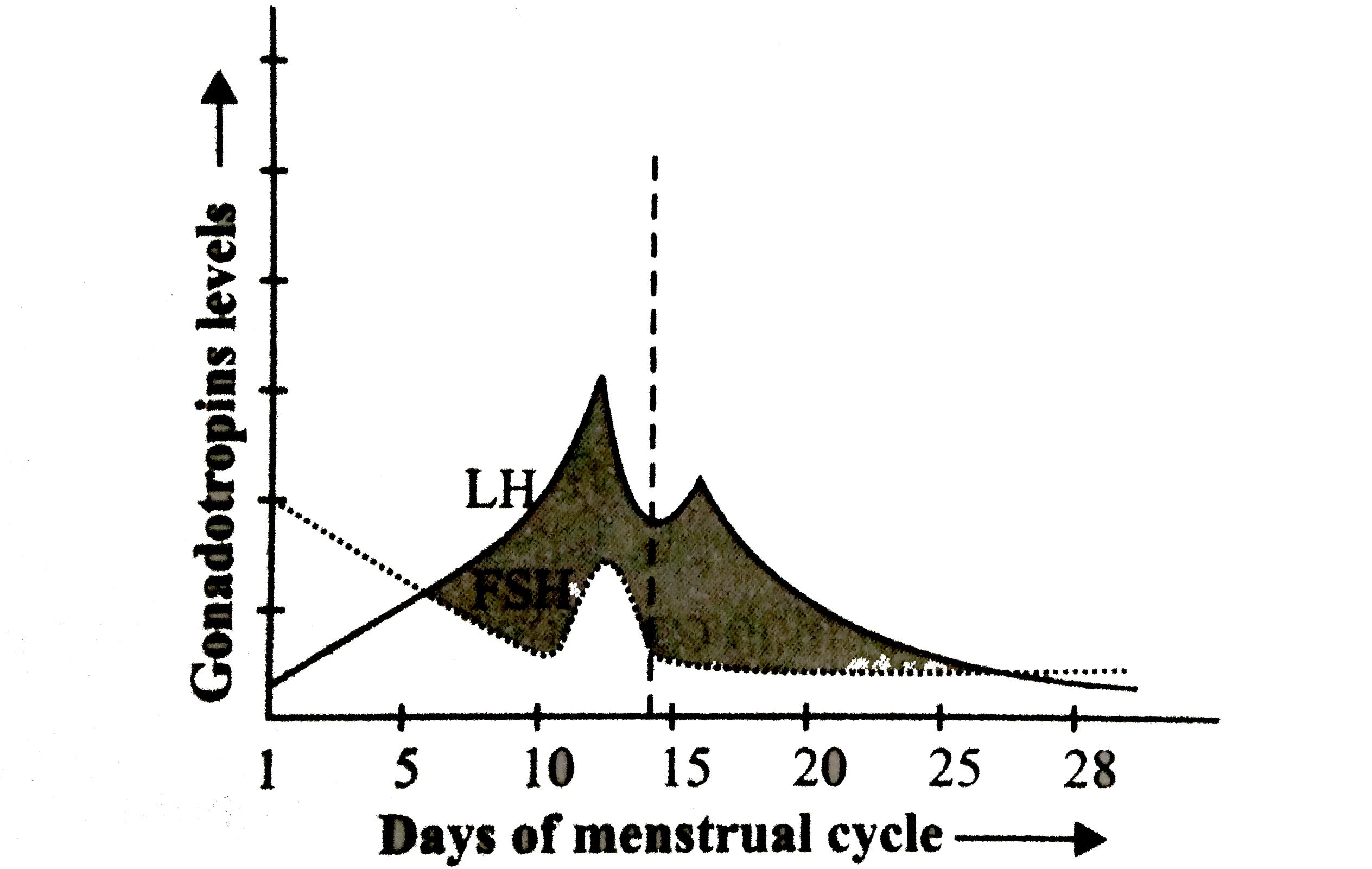Read the graph given here and correlate the uterine events that take place according to the hormonal levels on

(a) (i) 6-15 days (ii) 16-25 days (iii) 26-28 days (if the ovum is not fertilled )
(b) Specify the sources of the hormoes mentioned in the graph.
(a) (i) Estrogen first increases and then decreases but progesterone almost reains constact .
(ii) Estogen nearly remains costact but progesterone increases.
(iii) Estrogen level increases but progeterone decreases .
(b) Secretion of estrogens by the growing follicles .Secretion of large amount of progesterone by corpus luteum .
Topper's Solved these Questions
- HUMAN REPRODUCTION BOOK - PRADEEPCHAPTER - HUMAN REPRODUCTION EXERCISE - ADDITIONAL QUESTIONS (LONG ANSWER QUESTIONS)
70 Videos
- HUMAN REPRODUCTION BOOK - PRADEEPCHAPTER - HUMAN REPRODUCTION EXERCISE - ANALYTICAL QUESTIONS WITH ANSWERS
19 Videos
- HUMAN REPRODUCTION BOOK - PRADEEPCHAPTER - HUMAN REPRODUCTION EXERCISE - ADDITIONAL QUESTIONS ( VERY SHORT ANSWER QUESTIONS)
40 Videos
- EXCRETORY PRODUCTS AND THEIR ELIMINATIONBOOK - PRADEEPCHAPTER - EXCRETORY PRODUCTS AND THEIR ELIMINATIONEXERCISE - Curiosity Questions
7 Videos
- LOCOMOTION AND MOVEMENTSBOOK - PRADEEPCHAPTER - LOCOMOTION AND MOVEMENTSEXERCISE - NOTABLE QUESTIONS
2 Videos
Similar Questions
 Read the graph given above and correlate the uterine events that take place according to the hormonal levels on
Read the graph given above and correlate the uterine events that take place according to the hormonal levels on
(i) 6 - 15 days
(ii) 16 - 25 days
(iii) 26 - 28 days (if the ovum is not fertilised )
(b) Specify the sources of the hormones mentioned in the graph.
View Solution Read the graph given above and correlate the uterine events that take place according to the hormonal levels on
Read the graph given above and correlate the uterine events that take place according to the hormonal levels on
(i) 6 - 15 days
(ii) 16 - 25 days
(iii) 26 - 28 days (if the ovum is not fertilised )
(b) Specify the sources of the hormones mentioned in the graph.
View Solution
Knowledge Check

Study the garaph carefully and correlate the hormone levels on
(i) 1-5 days
(ii). 12-14 days
(iii). 25-28 days (if the ovum is not fertilised)A(i) LH decreases and FSH increases
(ii). LH increases and FSH decreases
(iii). LH level maintained and FSH level increasesB(i). LH increases and FSH decreases
(ii). LH decreases and FSH increases
(iii). LH level increases and FSH level maintainedC(i). LH increases and FSH decreases
(ii). LH peaks and FSH peaks
(iii). LH level decreases and FSH level maintainedD(i). LH peaks and FSH peaks
(ii). LH increases and FSH decreases
(iii). LF level decreases and FSH level maintained.
Study the garaph carefully and correlate the hormone levels on
(i) 1-5 days
(ii). 12-14 days
(iii). 25-28 days (if the ovum is not fertilised)A(i) LH decreases and FSH increases
(ii). LH increases and FSH decreases
(iii). LH level maintained and FSH level increasesB(i). LH increases and FSH decreases
(ii). LH decreases and FSH increases
(iii). LH level increases and FSH level maintainedC(i). LH increases and FSH decreases
(ii). LH peaks and FSH peaks
(iii). LH level decreases and FSH level maintainedD(i). LH peaks and FSH peaks
(ii). LH increases and FSH decreases
(iii). LF level decreases and FSH level maintained.
 Read the graph given above and correlate the uterine events that take place according to the hormonal levels on
Read the graph given above and correlate the uterine events that take place according to the hormonal levels on
(i) 6 - 15 days
(ii) 16 - 25 days
(iii) 26 - 28 days (if the ovum is not fertilised )
(b) Specify the sources of the hormones mentioned in the graph.
View Solution Read the graph given above and correlate the uterine events that take place according to the hormonal levels on
Read the graph given above and correlate the uterine events that take place according to the hormonal levels on
(i) 6 - 15 days
(ii) 16 - 25 days
(iii) 26 - 28 days (if the ovum is not fertilised )
(b) Specify the sources of the hormones mentioned in the graph.
View SolutionStudy the graph given below related with menstrual cycle in females:
a. Identify ovarian hormones X and Y mentioned in the graph and specify their source.

Corelate and describe the uterine events that take place according to the ovarian hormone levels X and Y mentioned in the graph on -
i. 6 – 15 days
ii. 16 – 25 days
iii. 26 – 28 days (when ovum is not fertilized)
View SolutionRead the graph given beow. Correlate the ovarian events that take place in the human femaek according to the level of the pituitary hormone during the following day.

(i) 10th - 14th days (ii) 14th - 15th days (iii) 16th - 23th days (iv) 25th - 29th days
(If the ovum is not fertilised)
View Solution(a) The diagram given below is that of a developing human foetus in the womb. Study the same and then answer the questions that follow :

(i) Name the parts '1' and '5' indicated by guidelines.
(ii) What term is given to the period of development of the foetus in the womb ?
(iii) How many days does the foetus take to be fully developed ?
(iv) Mention two functions of the part labelled 2 other than its endocrine function.
(v) Name the hormone (any one) produce by the part labelled 2
(vi) What is the function of the part marked 3 ?
(b) Give the exact location of amnion.
[ICSE 2011, 2014]
View SolutionExplain the events in a normal woman during her menstrual cycle on the following days :
(a) Pituitary hormone levels from 8 to 12 days.
(b) Uterine events from 13 to 15 days.
(c) Ovarian events from 16 to 23 days.
View Solution
